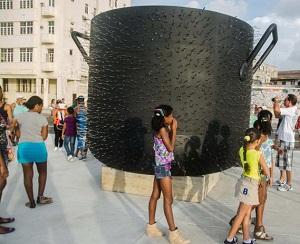 The confirmation of the international artists from 52 nations set to participate in the 12th Havana Biennial, April 12 through May 12, is an unequivocal sign of the interest aroused in the most important visual arts event organized by Cuba, and of the clear cultural policy committed to its continuity.
The confirmation of the international artists from 52 nations set to participate in the 12th Havana Biennial, April 12 through May 12, is an unequivocal sign of the interest aroused in the most important visual arts event organized by Cuba, and of the clear cultural policy committed to its continuity.
This is even more significant if we take into account the organizational and logistical requirements of a highly complex and comprehensive event, which takes place in the midst of a strained finance situation and the tightening of the blockade, to which we must add certain actions aimed at detracting from this festival of the most advanced visuality.
In the final stretch of preparations, organizers assured that the theme of this Biennial, “La construcción de lo posible” (Construction of the Possible), is about to become a reality.
Faithful to its original intention to support Third World arts, featuring are participants from Central America and the Caribbean (32 artists), South America (21), Africa and the Middle East (23) and Asia and Oceania (27), with the particularity that from this last region 11 artists from China and the same number from Australia will attend. In total, some 300 foreign creators will participate in the event, according to Jorge Alfonso, executive director of the Biennial.
For the guest Cuban artists – 17 with individual projects and 68 in collective projects – participating in the main exhibitions, the upcoming Biennial represents a new opportunity to present their work to the world. Looking at the list of 85 national artists featuring at the core of the event, one notes that there is a wide age range. Alongside creators with an already recognized and established career, several of whom have been awarded the National Visual Arts Prize, are others whose more recent beginnings guarantee the constant renewal of aesthetic codes that keep contemporary Cuban art alive.
If the Biennial is important for the artists, it is also very significant for the public. Firstly, because Havana will become, perhaps even more so than in the last editions, a vast open gallery. Secondly, it offers the possibility of enriching experiences and visual heritage.
Exponents will occupy more than 30 cultural institutions, museums and galleries of the Cuban capital, including Pabellón Cuba, the La Acacia, Villa Manuela, and Orígenes galleries, as well as spaces in the city’s central historic district, and the Hispano-American Cultural Center; while the National Museum of Fine Arts will host a project based on extensive and rigorous research. Other venues include public spaces, including along Línea Street, with a project led by architect Vilma Bartolomé; and the Malecón, which will host the third edition of Detrás del muro, an open-air exhibition organized by curator Juan Delgado Calzadilla, featuring works by more than 60 artists.
Beyond Havana, several other provinces will be part of the Biennial program: the Farmacia project, in Pinar del Río; Magdalena Campos’ Ríos intermitentes initiative, in Matanzas; the collective exhibition Mar adentro, in Cienfuegos; and the Video Art Festival, in Camagüey.